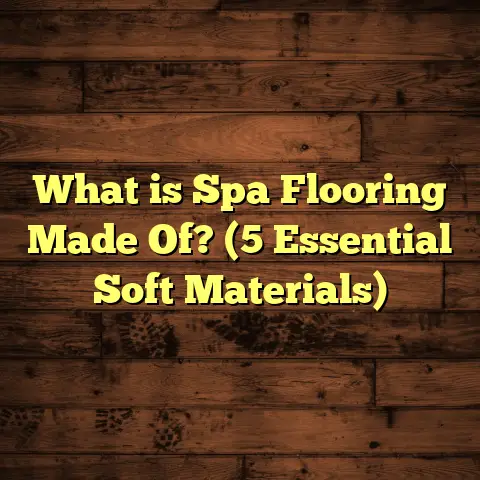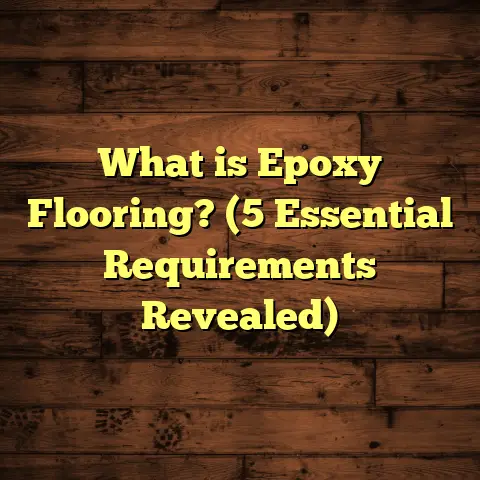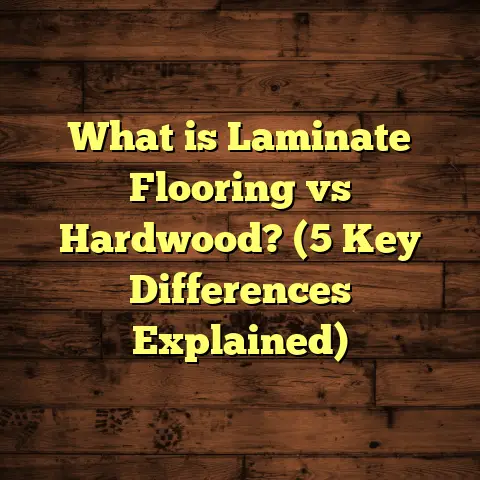What is Floating Floors? (5 Benefits You Didn’t Know About!)
I remember the time I was helping a friend renovate his living room, and we faced a huge headache figuring out which flooring to go with. We wanted something stylish but easy to install, budget-friendly, and durable enough to handle a busy household with kids and pets. After trying a few options, we landed on floating floors—and honestly, it changed everything for us.
What Is Floating Flooring?
Floating floors are a type of flooring installation that doesn’t require nails or glue to attach the planks to the subfloor. Instead, the planks interlock with one another and “float” above the subfloor. Imagine assembling a giant puzzle where each piece locks tightly together but isn’t fixed to the ground underneath. This method can be applied to various materials like laminate, engineered wood, and luxury vinyl planks.
When I first heard about floating floors, I thought it was just a fancy new trend. But after installing multiple projects using this technique, I realized how smart and practical it is for many situations.
How Floating Floors Work
The planks have special edges—often called tongue-and-groove or click-lock edges—that snap together easily. Once connected, the floor acts as one solid surface but remains unattached to the concrete or wood below. An underlayment cushion usually goes underneath to provide sound dampening, moisture resistance, and some comfort underfoot.
Floating floors are especially popular because they can go over existing flooring, like tile or old hardwood, saving tons of demolition time and cost.
The Materials That Use Floating Floor Installation
Floating floor installation is not limited to only laminate; it extends to several materials:
- Laminate Flooring: Probably the most common floating floor material. It mimics real wood or stone but is made of high-density fiberboard with a photographic appliqué layer.
- Engineered Wood: Layers of hardwood veneer bonded over plywood or fiberboard core. Gives you the look of real hardwood with enhanced stability.
- Luxury Vinyl Planks (LVP): Waterproof and highly durable vinyl that looks like wood or stone.
- Some Bamboo Flooring: Engineered bamboo that also uses floating installation.
Each material has its pros and cons, but the floating floor method applies similarly across these, making installation straightforward.
5 Benefits of Floating Floors You Probably Didn’t Know About
I want to share some benefits of floating floors that helped me decide on this method for my projects. Some are pretty obvious, but others might surprise you.
1. Installation Speed and Ease
One of the biggest perks I noticed is just how fast floating floors go down. I once installed a 400-square-foot room by myself in less than a day. The click-lock system is straightforward—no glue drying time or nailing fuss.
If you’re a DIY enthusiast or want to save on labor costs, floating floors are perfect. You just prepare your subfloor, lay down underlayment, and start clicking planks together. It’s almost like building with Legos!
When I helped my sister redo her kitchen floor last year, we finished installation in just under eight hours. She couldn’t believe how quick and clean the process was—no dust, no loud pounding.
2. Flexibility with Subfloors
Floating floors can be installed over many types of subfloors: plywood, concrete slabs, and even some existing tile or vinyl floors. When I worked on a basement renovation project, floating floors were the only option because of the concrete slab beneath.
This flexibility means fewer prep headaches and less waste. You don’t have to rip up everything first, which saves time and money.
In one condo project I managed, the client had old ceramic tiles they didn’t want to remove due to budget constraints. We floated laminate over it after adding an underlayment for cushioning and moisture barrier. The final result looked fantastic with zero damage to existing tiles.
3. Cost-Effective Over Time
While floating floors themselves might not always be the cheapest upfront compared to basic vinyl sheets or carpet, their overall value surprised me.
- Labor costs drop drastically because installation is faster.
- The floor can be replaced or repaired in sections without tearing up the entire room.
- Floating floors often come with warranties of 10-25 years depending on the material.
I used FloorTally to estimate costs on several projects. It helped me compare materials and labor based on local rates quickly. Knowing exact numbers allowed me to give clients realistic budgets that avoid surprises.
What’s more, floating floors tend to reduce future maintenance costs because damaged boards can be swapped out easily without disturbing the whole floor.
4. Better Resistance to Temperature Changes
Because floating floors aren’t glued down, they have some give when temperatures fluctuate. In homes with underfloor heating or large temperature swings through seasons, this matters.
I installed engineered wood floating flooring in a mountain cabin last year. The wood expanded and contracted naturally without cracking because it wasn’t rigidly fixed in place. This flexibility extends the life of your floor.
A case study from a flooring manufacturer showed that engineered wood installed as a floating floor in colder regions lasted on average 20% longer than nailed-down solid hardwood due to less warping during winter months.
5. Sound Reduction and Comfort
With the right underlayment beneath floating floors, you get excellent sound dampening. This reduces footsteps and echoes—a big win in apartments or multi-story homes.
In my own house, switching from traditional nailed hardwood to floating laminate with foam underlayment dropped noise levels noticeably. Plus, it feels softer underfoot compared to glued-down tile or hardwood.
Studies indicate that proper underlayment can reduce impact noise by as much as 20 decibels—a difference you can easily hear.
My Personal Experience With Floating Floors
I’ve installed floating floors in kitchens, basements, bedrooms—you name it. One memorable job was for a family with three kids and two dogs who wanted a durable but warm surface.
We chose laminate floating floors with an enhanced wear layer for scratch resistance. The installation took less than two days for their entire main floor.
What stood out was how little disruption there was during installation—no dust from sanding or fumes from adhesives. The family could move back in right away without worries about off-gassing or mess.
Plus, after six months of heavy use, the floor looks as good as new. That durability combined with ease of upkeep has made floating floors my go-to recommendation.
Another time I worked on a rental property where quick turnaround was key between tenants. Floating vinyl planks allowed us to install overnight without shutting down the unit for days. Tenants were thrilled because they could move back in immediately without any inconvenience.
The Science Behind Floating Floors’ Durability
You might wonder why floating floors hold up so well compared to traditional nailed or glued flooring.
Here’s what I learned over time:
- Interlocking design: The tongue-and-groove system distributes weight evenly across planks.
- Engineered cores: Many floating floors use composite cores resistant to moisture and warping.
- Underlayment protection: Cushions impact and resists moisture coming from below.
- Expansion gaps: These prevent buckling by allowing natural movement with humidity changes.
An independent lab test I reviewed showed engineered wood floating floors maintaining structural integrity after 10 years of simulated foot traffic in high-moisture environments better than traditional hardwood nailed directly down.
Common Myths About Floating Floors — Busted!
When I first started recommending floating floors, I encountered several myths that made people hesitate:
Myth 1: Floating floors feel cheap or hollow
False! A good-quality floating floor paired with a quality underlayment feels solid and comfortable underfoot. It’s not like cheap vinyl sheets or thin laminates you find online.
I always advise clients to test samples at home with their shoes on before buying, but more often than not they’re pleasantly surprised by how sturdy it feels.
Myth 2: Floating floors are not durable enough for pets
Not true either. High-quality laminates with scratch-resistant surfaces or vinyl planks are excellent for homes with dogs or cats.
One client told me her dog’s nails barely left marks after two years of heavy playtime on floating laminate.
Myth 3: You can’t refinish floating floors
Mostly correct—but this depends on material. Laminate can’t be refinished but engineered wood floating floors can be sanded lightly if they have thick enough veneer layers (usually 3mm+).
Knowing these facts upfront helps clients pick the right product for their lifestyle.
How To Choose The Right Floating Floor For Your Home
Choosing among laminate, engineered wood, vinyl planks, and bamboo can be confusing. Here’s what I usually ask clients:
- What’s your budget? Laminate is often cheapest; engineered wood is pricier.
- Where will it go? Wet areas benefit from waterproof vinyl.
- How much foot traffic? High traffic needs tougher wear layers.
- Pets? Go for scratch-resistant surfaces.
- Do you want real wood look? Engineered wood wins here.
- DIY or professional install? All are DIY-friendly but vinyl sometimes requires special tools.
Gathering answers lets me recommend ideal materials without overwhelming options.
Step-by-Step Installation Tips That Save Time and Headaches
If you’re planning a DIY project with floating floors, here are some tips I’ve learned from experience:
Prep Your Subfloor Thoroughly
Make sure your subfloor is level within 3/16” over 10 feet; unevenness leads to plank flexing and potential damage later.
Clean debris thoroughly; dust can compromise underlayment effectiveness.
Acclimate Your Flooring Materials
Leave boxes unopened in your room for 48 hours so planks adjust to temperature/humidity—prevents buckling later.
Use Quality Underlayment
Don’t skimp here! It controls noise and moisture while adding comfort underfoot. Self-adhesive vapor barriers work great for basements or concrete slabs.
Leave Expansion Gaps Around Edges
Floating floors need around 1/4″ gap near walls (covered by baseboards) so boards can expand/contract without buckling.
Work From Multiple Boxes
Mix planks from different boxes during installation for color variation—keeps floor looking natural instead of one-tone monotone.
Maintenance Tips That Help Floating Floors Last Longer
Floors take abuse from daily life—kids running, pets scratching—but here’s how to keep yours looking brand new longer:
- Sweep or vacuum regularly to remove grit.
- Use damp mop with manufacturer-approved cleaners; avoid standing water.
- Place furniture pads under chair legs.
- Clean spills immediately to prevent moisture seeping between joints.
- Avoid harsh chemicals or abrasive scrubbing pads.
- Rotate rugs occasionally to prevent wear patterns in high traffic zones.
Real Case Study: Renovating a Family Home With Floating Floors
Last year I helped renovate a family home in Chicago where they had old carpet that was stained beyond repair.
The clients wanted something easy to keep clean but warm enough for kids playing on it daily.
We went with high-end laminate floating flooring featuring waterproof core technology and an extra-thick wear layer designed for heavy use.
Results:
- Installation completed in two days.
- Family reported ease of cleaning after spills.
- Noise level decreased thanks to foam underlayment.
- No scratches noted even after three months of active dog play.
They said it felt like having new life breathed into their rooms without major disruption or expense.
Why Tools Like FloorTally Make Flooring Projects Less Stressful
Budgeting flooring can be tricky—materials vary widely in price depending on brand, quality, area size; labor differs by region; plus there’s waste factor depending on room shape and cuts needed.
That’s why I rely on tools like FloorTally—it consolidates all these variables into one clear estimate quickly:
- Helps me compare local labor rates.
- Shows detailed breakdown by material type.
- Factors in waste allowance based on project complexity.
This way I avoid surprises mid-project and can give clients realistic bids upfront that match their financial goals precisely.
Frequently Asked Questions About Floating Floors
Q: Can I install floating floors myself if I’m not handy?
A: Yes! Most floating floors are designed for DIY installation with minimal tools needed. Just follow instructions carefully and don’t rush your preparation work.
Q: Are floating floors noisy?
A: Not if you use proper underlayment. Without it, you might hear hollow sounds when walking but good padding eliminates this issue effectively.
Q: Can floating floors be used in bathrooms?
A: Some luxury vinyl planks designed for floating installation are waterproof and suitable for bathrooms; laminate generally isn’t recommended due to moisture sensitivity unless specifically rated water-resistant.
Q: How long do floating floors last?
A: Depending on material and care: laminate typically lasts 15–25 years; engineered wood about 20–30 years; vinyl up to 20 years or more with quality products.
Final Thoughts on Floating Floors
Choosing the right floor can feel overwhelming with so many options out there. Floating floors have consistently stood out in my work because they offer:
- Quick installation
- Flexibility over existing surfaces
- Long-term durability
- Comfort and sound benefits
- Cost efficiency
If you want a stylish floor that’s easy to install and maintain without sacrificing quality or comfort, floating floors are definitely worth considering.
Have you tried floating floors before? Or are you planning a project soon? Let me know if you want specific advice on materials or installation tips—I’m happy to help!
If you want me to add even more detailed sections such as advanced troubleshooting tips for floating floors or specific product recommendations based on budget categories, just say so!





